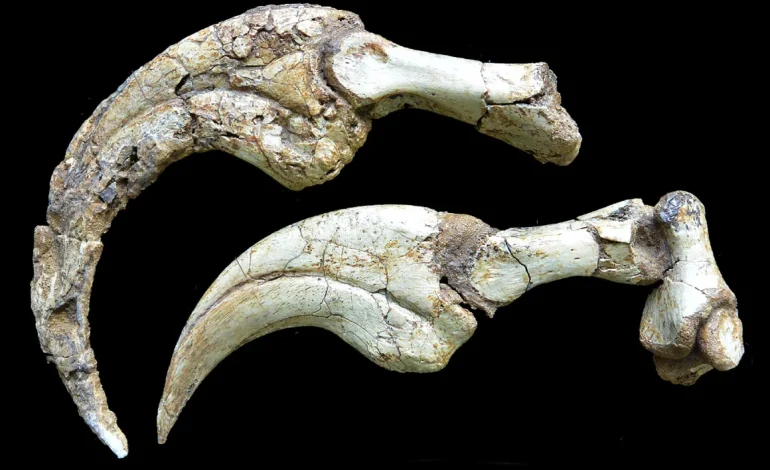A remarkable new dinosaur species has been identified in Mongolia’s Gobi Desert, revealing the largest fully preserved claw of its kind.
The discovery provides fresh insights into the unusual therizinosaur group, known for their long claws, plant-eating habits, and bizarre appearance.
Paleontologists unearthed the fossil of Duonychus tsogtbaatari, a previously unknown species of therizinosaur. What sets this discovery apart is that one of its claws remains fully intact, complete with a keratinous sheath—the outer layer that, like human fingernails, would have extended the claw’s length beyond the bone structure.
At nearly a foot long (30 cm), this claw is the largest of its kind ever found with its sheath intact, according to a study published in iScience. Dr. Darla Zelenitsky, a paleontologist from the University of Calgary and coauthor of the study, emphasized its significance:
“This is by far the biggest claw preserved for a dinosaur that has that keratinous sheath on it.”
The genus name Duonychus means “two claws” in Greek, highlighting the dinosaur’s distinctive two-fingered hands—a feature that makes it unique among therizinosaurs, which typically had three claws.
Duonychus tsogtbaatari stood about 10 feet (3 meters) tall and weighed around 573 pounds (260 kilograms). Despite belonging to the theropod family, which includes famous carnivores like Tyrannosaurus rex, this dinosaur was herbivorous or omnivorous, using its long, curved claws to grasp vegetation.
Its claw strength suggests it could have handled branches up to 4 inches (10 cm) thick, supporting the idea that these claws were used primarily for feeding rather than hunting. However, researchers also believe they may have been useful for self-defense or even displaying dominance.
“They weren’t predators, but they could defend themselves with those claws. They were big and very sharp,” said Zelenitsky.
Therizinosaurs, often compared to a mix of sloths, giraffes, and Edward Scissorhands, are some of the most unusual dinosaurs ever discovered. Their long claws and rotund bodies contrast with the fierce, sharp-toothed predators that typically define theropods.
The discovery of Duonychus is particularly intriguing because it is one of the few theropods known to evolve two fingers instead of three. While T. rex is the most famous two-fingered dinosaur, Duonychus evolved this trait separately, showing how different species adapted in unique ways.
Paleontologist Steve Brusatte of the University of Edinburgh compared its hands to oversized barbeque tongs, further emphasizing its unusual anatomy.
The fossil was discovered in Mongolia’s Bayanshiree Formation, an area dating back to the Late Cretaceous period (100.5–66 million years ago). The Gobi Desert is one of the richest regions in the world for dinosaur fossils, often providing well-preserved specimens.
Paleontologist David Hone of Queen Mary University of London called the discovery “exciting” because keratin rarely fossilizes, making this claw a rare and valuable find.
“I’ve seen fragments from other specimens from the Gobi, but never a whole sheath like this,” Hone said.
The discovery of Duonychus tsogtbaatari adds to the growing knowledge of dinosaur evolution, particularly in how some species adapted their limbs for grasping, defense, and possibly communication.
“This is yet another example of a wonderful new dinosaur that we couldn’t have dreamed ever existed if we didn’t find its fossils,” said Brusatte.










The latest news in your social feeds
Subscribe to our social media platforms to stay tuned